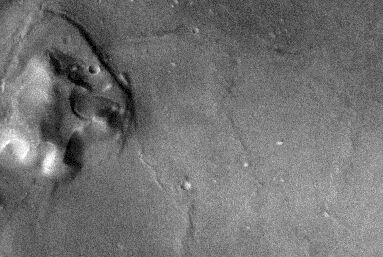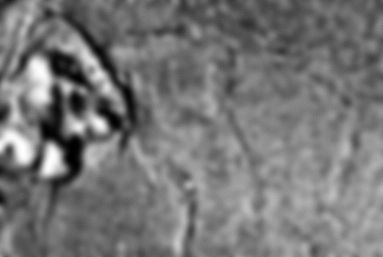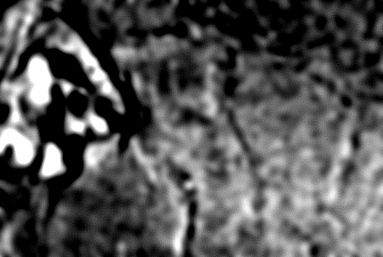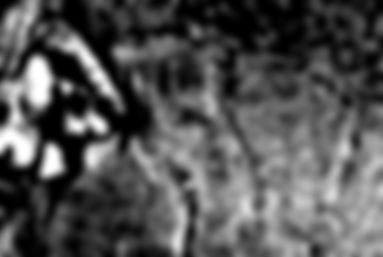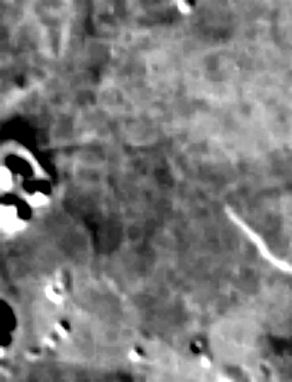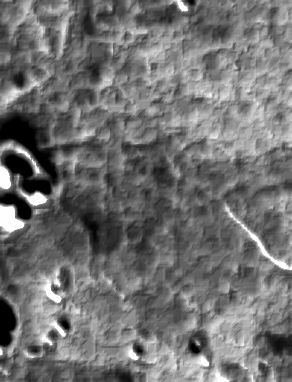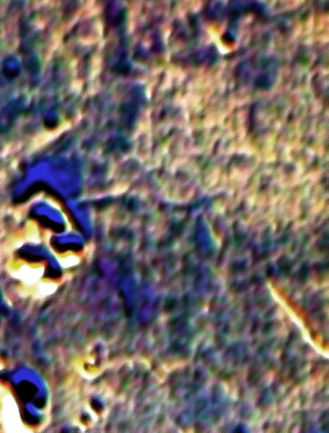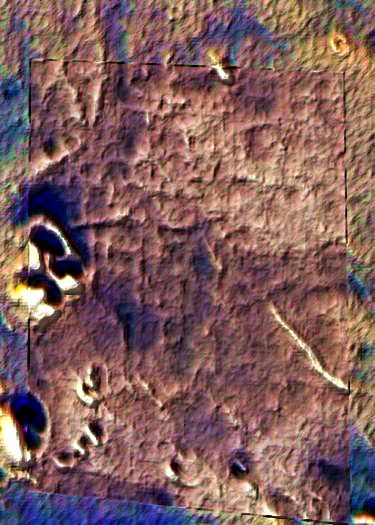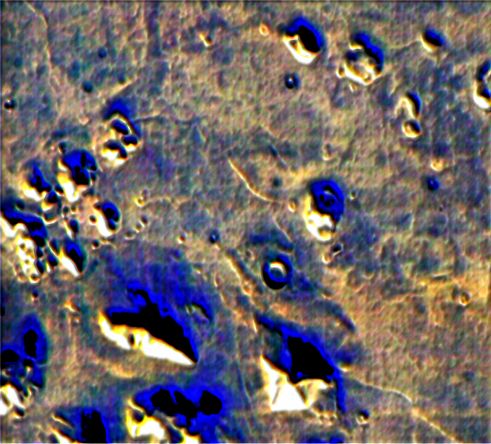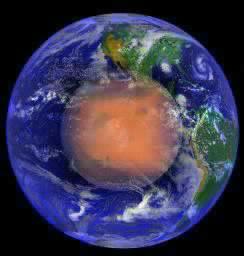 Cydonia Quest C Image Enhancements C Further Experimental Analysis of the First Infra-red Image of Cydonia Part Two C In response to Part One of this article Dr. Mark Carlotto of the on-line periodical New Frontiers in Science (µµµ) e-mailed me with the following advice - "Bob, I am always suspicious of grids that are aligned with the image frame. They are almost always processing artifacts." (Note: In this case alignment with the image frame means a north-south alignment). This part of the article is therefore devoted to finding corroborative evidence that the thermal grids that were found in Part One (µµµ) actually exist as real infra-red (IR) features on the surface of Cydonia. In Part One we saw that these grids are separate from the scan line noise effect - but how can we be sure that they aren't just another kind of imaging artefact? In order to assuage such doubts I therefore consulted the Mars Odyssey visible light image of this part of Cydonia to see what image enhancement might tell us about faint surface features in the area. The first image below shows the area to the east of the "Fort" as it appears after contrast and brightness optimisation. The next three images show the same area after various treatments using ultra-contrasting and blurring to get rid of extraneous detail or speckling. (Blurring has the effect of averaging the brightness over small areas allowing us to make out the bigger patterns within the landscape). The resulting patterns of light and dark are probably due to subtle differences in the elevation or reflectivity of the land as it catches the Sun. The geometric quality of this landscape is very striking, especially the box shaped features close to the "Fort" itself. (Images best viewed about four feet from computer screen). These box like features are of a size and positioning that match up with those seen in the analysis of the 24th July Cydonia daytime IR image (µµµ). The general north-south and east-west alignments seen in Part One and in the "Grill" landscape (µµµ) are also in evidence. There is not an exact line-by-line match with the thermal features seen in the IR image, but it must be remembered that the visible light image has a resolution five times greater than the IR one - and that the IR image is bound to be picking up things that are different from those seen in visible light.
|
| c These four illustrations show the area in visible light. cccccccccccccccccccccccc cccccccccccccccccccccccc cccccccccccccccccccccccc cccccccccccccccccccccccc c These two images show Cydonia Quest enhancements of the same area in the infra-red image of the 24th July 2002 for comparison.
c As the material above was being prepared a second source of corroborating evidence became available. There are currently two official sets of multispectral IR images of this area of Cydonia available, taken on two different dates. In addition to the set released on the 24th July on the Mars Odyssey website (in which the evidence of a thermal grid was first found) there is also the set of raw images released to the PDS in October 2002. Part One began with an effort to extract information from the latter set of images but found the level of "scan line" noise too distracting to draw concrete conclusions. Keith Laney has now cleaned up this second set of IR image bands and amalgamated them using de-correlation stretch. The results can be seen at his website under the title "I0204002", (click this "stargate" µµµ). It is obvious from a quick glance at Laney's decorrelation stretch images that they also contain something like the grids seen in the IR image of the 24th July and in the visible light image. The images displayed on Laney's website are in JPEG file format, which is not suitable for image enlargement. I therefore contacted Laney and asked him to provide a crop from one of his decorrelation stretch images in a higher quality file format and he swiftly complied with my request. The display below compares the image enhancement of the thermal grids seen in the 24th July IR image (left) with the same area taken from Laney's decorrelation stretched work on the second IR image set, similarly enhanced (right). Both of these images contain a grid-like IR landscape of cells surrounded by thermal "walls". Closer inspection reveals a very strong one-for-one correlation between the cells and "walls" seen in the first daytime IR image of this part of Cydonia and those seen in the second, October release. c Original de-correlation stretch imagery of the October IR release of Cydonia provided courtesy of Keith Laney
cccccccccccccccccccccccc C In order to gauge just how well the thermal grids seen in the two images agreed, the overlay experiment seen in the third image above was created. A section of the image released on 24th July was contrast enhanced and given a rose coloured tint. Similarly a slightly larger section from the second image released in October was also contrast enhanced. The first image was then overlayered as a transparency over the second image, so that the overlay area was a 50/50 visual average of the two images. The combined image was then subjected to a minor BUMP map treatment to give a 3-D effect and some sharpening was applied to make things look crisper. The interesting thing is that rather than conflicting with each other in the overlay area, the grids from the two images reinforce one another. As the two IR images were actually taken about four months apart this means that the thermal grids cannot be imaging or processing artefacts as these kind of artefacts have a random element which would cause the two images to contradict each other. There seems to be no way at this stage to determine whether these faint thermal grids are artificial or due to a geological phenomenon. However, they are clearly archaeological looking in their appearance and are one more piece of evidence in the jigsaw puzzle pointing to a long lost civilisation on Mars. The final image below is an enhanced 50% reduction of the image that Keith Laney provided. Although problems with "scan line" noise are still evident in the image, close inspection shows that the thermal grids to the east of the "Fort" are clearly unique and separate from any noise effects. In visible light the Cydonia plain is fairly flat and featureless, but the infra-red landscape is extremely varied indeed. A case in point is the artificial looking set of large IR "basins" that fill the right hand side of the image close to the central axis where nothing of the sort can be seen in visible light images of the area. C ccccccccccccccc C µ Return to Part 1 µ Forward to Part 3 µ Forward to Part 4 µ Return to the Enhancements page
|
